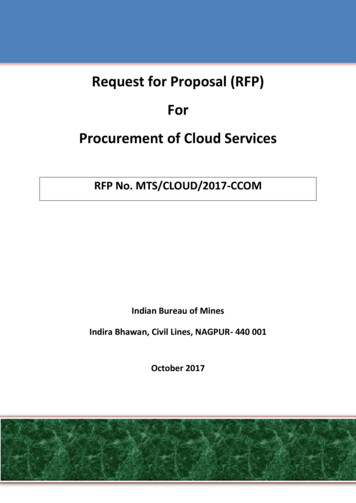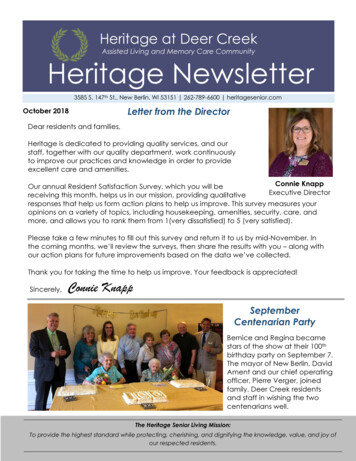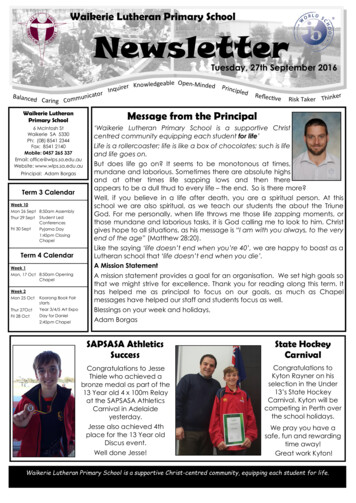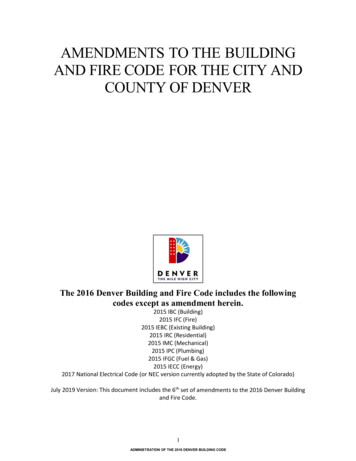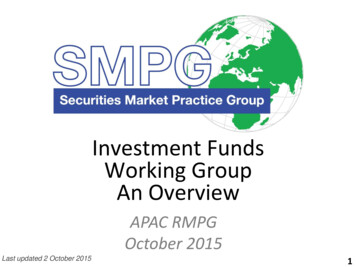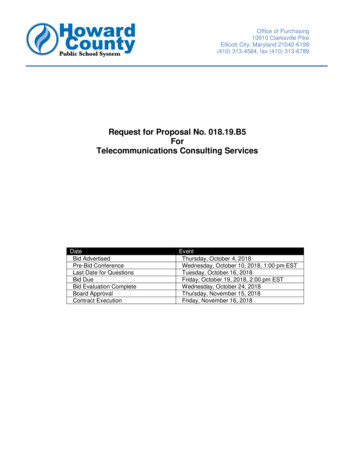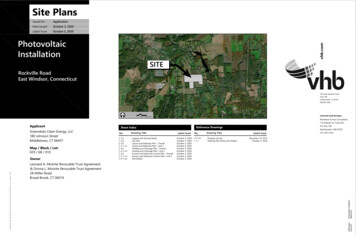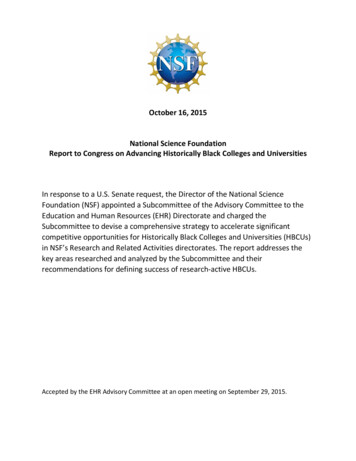
Transcription
October 16, 2015National Science FoundationReport to Congress on Advancing Historically Black Colleges and UniversitiesIn response to a U.S. Senate request, the Director of the National ScienceFoundation (NSF) appointed a Subcommittee of the Advisory Committee to theEducation and Human Resources (EHR) Directorate and charged theSubcommittee to devise a comprehensive strategy to accelerate significantcompetitive opportunities for Historically Black Colleges and Universities (HBCUs)in NSF’s Research and Related Activities directorates. The report addresses thekey areas researched and analyzed by the Subcommittee and theirrecommendations for defining success of research-active HBCUs.Accepted by the EHR Advisory Committee at an open meeting on September 29, 2015.
Report to Congress on Advancing Historically Black Colleges and UniversitiesBy the Subcommittee on Advancing Historically Black Colleges and Universities of the AdvisoryCommittee of the National Science Foundation Directorate for Education and Human ResourcesI.Executive SummaryThe Senate requested that the National Science Foundation (NSF) convene a high-level panel, comprisedmostly of leaders of Historically Black Colleges and Universities (HBCUs) with strong graduate programs,to devise a comprehensive strategy to accelerate significant competitive opportunities for HBCUs inNSF’s Research and Related Activities (R&RA) directorates. In response, NSF charged a Subcommittee ofits Advisory Committee for the Directorate for Education and Human Resources (EHR), led by Dr.Tuajuanda Jordan, president of St. Mary’s College of Maryland, with researching and reporting on theissue.The Subcommittee concluded that there are currently three categories of HBCUs in relation to NSF:those that have been successful in obtaining funding from both the R&RA and EHR directorates; thosethat are in transition to more research-active status, but currently receive the bulk of their funding fromEHR, especially the Historically Black Colleges and Universities – Undergraduate Program (HBCU-UP);and those that only rarely, if at all, apply for NSF funding. The subcommittee analyzed the issuessurrounding each of the three groups and developed recommendations for increasing their success atNSF, including, as requested by the Senate, measurable milestones.Key Recommendations for HBCUs:1. HBCUs will work with NSF to obtain technical assistance and advice in preparing submissions forthe Faculty Early Career Development Program (CAREER) or other single-investigator awards inthe R&RA directorates. Institutional submissions should increase to 25% of each new facultycohort within the next five years.2. HBCUs will do an assessment to determine internal impediments faced by their faculty thatprevent significant numbers from submitting R&RA proposals. As part of their proposals to theHBCU-UP Research Initiation Awards (RIA) program, the HBCU will be required to identify theimpediments and submit a proposal to address the internal challenges. HBCU-UP RIA shouldmandate this information as part of the application submission process as well as institute therequirement that applicants include a 10-year plan for transitioning faculty from that fundingmechanism to submissions to the R&RA directorates.3. To the extent possible, HBCUs will provide resources (human and financial) to junior faculty asthey establish their research agendas. The amount of funding dedicated to start-up resourcesfor junior faculty should increase to the 50th percentile of that provided by the average researchactive HBCU within five years of the release of this report.4. HBCUs should work with NSF to identify centers near HBCUs that could involve the HBCUs intheir education and outreach activities. All NSF centers and large facilities (e.g., EngineeringResearch Centers, Science and Technology Centers, Materials Research Science and EngineeringCenters, LIGO, astronomy) have required education and outreach components. These activitiesprovide opportunities for both faculty and students at all levels to become involved in cuttingedge research.5. Beginning in FY2017, all HBCUs applying for grants in EHR programs should include as part of theapplication process 10-year development plans to 1) prepare their faculty to become moreresearch-active and 2) build a research-support infrastructure within their institution.1
Key Recommendations for NSF:1. NSF will further analyze the issues related to multi-institution versus single investigator awardsand explore ways in which to encourage more HBCU applicants for single investigator awards,including CAREER awards. An internal review and report by NSF will be conducted.2. NSF will explore additional mechanisms through which program staff can interact with faculty atHBCUs who are starting research careers. NSF will ensure that outreach to HBCUs through inperson sessions, webinars, etc. continues, especially in the R&RA directorates. Successfulprograms will be studied and replicated, if feasible.3. Beginning in FY2017, NSF should supply technical support to assist HBCUs in developing facultyand institutional research support programs.4. NSF should identify other funding agencies with which to partner to help HBCUs develop aresearch culture. This should be advertised to HBCUs by FY2018.5. NSF will explore ways to make programs that focus on broadening participation in both theR&RA and EHR directorates more widely known in the HBCU community. In addition, since 50percent of HBCUs are in Experimental Program to Stimulate Competitive Research (EPSCoR)states, NSF will work to foster increased interactions between the NSF EPSCoR office andHBCUs. NSF will hold internal meetings among the R&RA directorates, successful programs suchas HBCU-UP in EHR, and the NSF EPSCoR staff to explore options for better collaboration. Thesemeetings will be held and a plan developed during FY 2016.II.Introduction and Charge to the SubcommitteeIn Senate Report 114-66, entitled Department of Commerce and Justice, and Science and RelatedAgencies Appropriations Bill 2016, the Senate included instructions to the National Science Foundation(NSF) to “convene a high-level panel to devise a comprehensive strategy to accelerate significantcompetitive opportunities for HBCUs that can continuously tap NSF’s core research directorates ratherthan its education and human resources program base.” The Senate went on to indicate that the reportstrategy should include “measurable milestones” and that the panel should be “comprised primarily ofleaders from the Nation’s HBCUs with an emphasis on those institutions with strong graduate programsthat are successful at capturing Federal research funding.”In response, NSF convened a Subcommittee of the Advisory Committee for the Directorate for Educationand Human Resources, chaired by Dr. Tuajuanda Jordan (President, St. Mary’s College of Maryland).Other members of the Subcommittee include Drs. Sandra DeLoatch (Provost and Vice President forAcademic Affairs, Norfolk State University), Wayne Frederick (President, Howard University), José Goity(Professor, Hampton University and Jefferson Lab), Keith Hargrove (Dean of the College of Engineering,Tennessee State University), Melissa Hines (Director, Cornell Center for Materials Research, CornellUniversity), Everette Joseph (Professor of Atmospheric Science and Director of the Atmospheric SciencesResearch Center, University of Albany), Loretta Moore (Vice President of Research and FederalRelations, Jackson State University), Jagannathan Sankar (Distinguished University Professor andDirector of the NSF Engineering Research Center for Revolutionizing Metallic Biomaterials, NorthCarolina A&T State University), and George C. Wright (President, Prairie View A&M University). Drs.Meldon Hollis (former Associate Director, White House Initiative on HBCUs) and Lee Todd (Former Chair,Advisory Committee for the National Science Foundation’s Directorate for Education and HumanResources and President Emeritus, University of Kentucky) served as ex officio members of theSubcommittee.2
The Subcommittee was charged by the NSF Director Dr. France Córdova, with researching and analyzingseveral key areas: What are optimal strategies that the HBCU community might undertake to increase thecompetitiveness of HBCUs and HBCU faculty with NSF R&RA [Research and Related Activities]directorates? What kind of institutional commitments and institutional change would benecessary to begin that shift? How can NSF be involved in achieving this change? Pleaseinclude metrics that would define success. For example, are some HBCUs poised to move toCarnegie RU/VH and RU/H classification?Examine particular research programs within the R&RA directorates in which HBCU faculty havebeen most competitive and identify common characteristics across these programs that mightbe responsible for this success.There are many science and engineering faculty members in HBCUs who have been successfulin obtaining NSF R&RA funding. Determine any factors that have been key to their success.Several HBCUs have been successful in obtaining funding through R&RA directorates, bothdirectly and through partnerships with other institutions. Are there characteristic of theseHBCUs or these partnerships that have made them more competitive for NSF R&RA funding?To develop its response to the Senate’s request, the Subcommittee held an initial meeting inWashington, DC on June 5, 2015, followed by research on the questions in the charge, a conference callon June 15, 2015 and a second face-to-face meeting on July 29, 2015. The report was vetted by leadersat a group of HBCUs not represented on the Subcommittee and approved by the Subcommittee beforebeing submitted to NSF for forwarding to the Senate.The report begins with a brief overview outlining the context of HBCUs and the diversity among them. Itthen analyzes three groups of HBCUs and their relationships with NSF, especially the Research andRelated Activities (R&RA) directorates—HBCUs that have been consistently successful in obtaining R&RAfunding, HBCUs that aspire to compete for R&RA funding, and HBCUs that may benefit from NSFprograms but do not currently seek R&RA research funding. The period for the analyses was 2010-2014.Each section includes recommendations for both the HBCU community and NSF. The report ends with aconclusions section.III.Historically Black Colleges and Universities (HBCUs) and their Relationship to NSFHBCUs are a vital asset to the nation. There are 100 accredited HBCUs in the United States, rangingfrom small regional liberal arts colleges to large research-active universities with comprehensivegraduate programs. HBCUs comprise about three percent of all institutions of higher education (IHEs).They include community colleges, four-year institutions, and graduate degree-granting institutions, bothprivate and public. Fourteen HBCUs have accredited engineering programs. Twenty-one HBCUs offerthe Ph.D. in at least one STEM discipline. According to the National Center for Education Statistics(NCES), of the 100 HBCU institutions in America today, 30 offer doctoral programs and 56 providegraduate degree programs at the Master's level (2013). At the undergraduate level, 85 of the HBCUsoffer a bachelor's degree program and 25 of these schools offer associate degrees. There are twelvetwo- year institutions offering associate degrees (NCES, 2013).Historically Black Colleges and Universities have awarded a large share of bachelor's degrees to AfricanAmerican students in science, technology, engineering and mathematics (STEM), and between 2008 and2012, nine of the top ten institutions where African-American STEM doctorate recipients studied as3
undergraduates are HBCUs, as data by the National Center for Science and Engineering Statistics (NCSES)show (2015). In 2012, 8.5 percent of black undergraduates attended HBCUs; however, HBCUs awarded16.7 percent of the bachelor's degrees and 17.8 percent of the science and engineering bachelor'sdegrees to black students that year, an illustration of the importance of HBCUs to the nation’s STEMenterprise (NSF, 2015).HBCUs vary in size, mission, and focus. Twenty-nine HBCUs enroll fewer than 1,000 students, with nineof these having an enrollment of fewer than 500 students. Forty-seven HBCUs enroll between 1,000 and4,000 students; twenty-four HBCUs enroll over 4,000 students, with only two of these enrolling morethan 10,000 students (NCES, 2013).NSF has long supported HBCUs through both the EHR and R&RA directorates. Table 1 shows thenumber of HBCUs that have applied for and received NSF funding between 2010 and 2014, the periodchosen by the Subcommittee for analysis. About 30 percent of HBCUs neither applied for nor receivedfunding from the NSF during that period. The same is true for comparable non-minority-servinginstitutions across the U.S. Table 1 reveals that in any given year, between 10 and 20 percent of HBCUsreceive funding only from the EHR Directorate where the HBCU-Undergraduate Program (HBCU-UP) ishoused. HBCU-UP, in addition to providing support for STEM undergraduate education and research,also provides research support to faculty in all NSF funded disciplines via the Research Initiation Awardand Broadening Participation Research tracks. HBCU-UP has funded 85 of the 100 HBCUs to date,including 7 of the 12 community colleges. Other EHR divisions and programs also fund HBCU projects,although HBCU-UP remains the primary source of support in the EHR directorate. At present, about 50percent of HBCUs do not apply to the R&RA directorates for funding.The Subcommittee report focuses primarily on two sets of institutions: 1) HBCUs that are successful inobtaining R&RA funding (see Section IV) and 2) HBCUs in transition with aspirations to compete forR&RA funding (see Section V). These transitional institutions often rely on EHR programs, especiallythose housed in the Division of Human Resource Development (HRD) such as HBCU-UP, to build capacityin STEM education. Additionally, the report includes recommendations regarding the approximately 30HBCUs that do not as a rule apply for NSF funding.Table 1 – Number of HBCUs Applying for and Receiving NSF Funding20102011201220132014Applied for NSFFunding6770706667Received at least1 NSF Award3942413345Applied for R&RAFunding5554505148Received at least1 R&RA Award3028211424Thirty-five percent of the proposals submitted to R&RA programs by HBCUs between 2010 and 2014were submitted by five institutions: Howard University, Jackson State University, North Carolina A&TState University, Tennessee State University, and Tuskegee University. Three of these (North CarolinaA&T State University, Tennessee State University, and Tuskegee University) are land grant universitiesfounded in response to the second Morrill Act of 1890, which required states to establish a separateland grant college for Blacks if Blacks were being excluded from the existing land grant college. These4
land grant schools continue to receive annual federal funding for their research, extension and outreachactivities (Lee, 2013). Fourteen percent of the total proposals submitted by HBCUs to R&RA programswere submitted by North Carolina A&T State University. Howard University and Jackson StateUniversity, the two HBCUs classified as research universities by the Carnegie Classification, are highlysuccessful in receiving NSF R&RA funding, but are not land grant universities. Howard University is afederally chartered university that receives an annual congressional appropriation administered by theU.S. Department of Education.IV.HBCUs that are Successful in Obtaining Funding from the R&RA DirectoratesThe Senate language states that “NSF’s primary research directorates have a far more anemic trackrecord” in funding HBCUs than EHR and concludes that this is “a reality that the Committee believesmust change if the Nation is to take advantage of the country’s growing diversity to enhance America’seconomic competitiveness.” The Subcommittee agrees that both HBCUs and NSF can do more toincrease support to HBCUs, but it also applauds the considerable support that NSF, especially EHR, hashistorically provided to HBCUs (Table 2). In addition, it recognizes that the R&RA directorates are alsoproviding considerable support and that HBCUs may be more successful in obtaining funding from themthan is commonly perceived (Table 2).Table 2: HBCU Funding Rate for Competitive Proposals, FY ng Rate22%21%26%20%21%Awards 307FundingRate16%14%14%9%15%Table 3: IHE Funding Rate for Competitive Proposals, FY 73,6883,9403,522R&RAFunding Rate18%18%21%18%17%Awards undingRate24%22%24%22%23%In order to study the competitiveness of HBCUs in the R&RA directorates, the Subcommittee assessedthe state of HBCUs that competed for and received NSF funding between fiscal years 2010 and 2014. Toanalyze the competitiveness of the most research-active HBCUs, the Subcommittee initially focused on a5
cohort of nine of these HBCUs with solid track records of NSF funding. In alphabetical order, theseinstitutions were Alabama A&M University, Hampton University, Howard University, Jackson StateUniversity, North Carolina A&T University, Prairie View A&M University, Southern University and A&MCollege, Tennessee State University, and Tuskegee University.The Subcommittee took the identification of an appropriate peer cohort for these nine institutionsseriously, as the challenges to such matching are well known. The first matched cohort of nine peerinstitutions (most of them predominately white institutions (PWIs), but some minority-servinginstitutions) was chosen by NSF program officers on the basis of program size, scope, and geography.The Subcommittee expanded upon this initial pool by choosing an additional 18 matched institutions,two per chosen HBCU, using the current Carnegie Classification of Institutions of Higher Education.1Since few institutions have an exact match across all seven Carnegie Classification criteria, the panelfocused on selection criteria that are most important to research competitiveness: Level, Control,Graduate Instructional Program, Enrollment Profile, and Basic.2 When more than two matches werereturned, institutions in similar geographical areas were given preference.Five years of data (2010-14) were examined for the nine HBCUs and the 27-institution peer cohort (seeappendix D). These data are summarized in Table 4. This comparison was found to be relativelyinsensitive to the methodology used to select the peer cohort, and similar results were obtained whencomparisons were separately made to the NSF-chosen cohort of nine peer institutions or the 18Carnegie-Classification-based peer cohort.Table 4: Comparison of Proposals, Funding Rate, and Total Funds Received by Select Research-ActiveHBCUs to their Peer Cohort Institutions across NSF and by Program Type, FY 2010-2014NameTotalFundsFundRateTotalFundsR&RA Programs OnlyProposalsFundRateEHR Programs OnlyProposalsProposalsAll NSF ProgramsFundRateTotalFunds% of Totalfrom EHRAvg.RRAAwardAvgEHRAwardHBCU Avg.15817.6% 24 M5923.8% 15 M9913.9% 9 M61.6% 676 K 1.06 MPeer Avg.17815.9% 11 M2015.4% 3 M15816.0% 8 M26.7% 326 K 968 KTable 4 compares the average performance of 9 select, highly research-active HBCUs to the averageperformance of a 27-institution peer cohort. The data are institutional averages. For example, theaverage HBCU institution submitted 158 proposals over the period FY 2010–2014 and received a total of1carnegieclassifications.iu.edu/lookup listings/institution.phpThe Carnegie classification scheme is described at carnegieclassifications.iu.edu/descriptions/. TheLevel category is based on highest degree awarded, whereas the Control category differentiatesbetween public and private institutions. Graduate Instructional Program categorizes graduateeducation, with a special focus on the mix of graduate programs across fields of study. Enrollmentprofile provides a broad view of the student according to the mix of students enrolled at theundergraduate and graduate/professional levels. The Basic Classification is an update of the traditionalclassification framework developed by the Carnegie Commission on Higher Education in 1970.26
24 M in NSF funding, while the average institution in the peer cohort submitted 178 proposals over thesame period and received 11 M in NSF funding.ConclusionsOn the basis of this comparison, a number of conclusions regarding the HBCUs that have had the mostsuccess in obtaining funding from the R&RA directorates are apparent: While it is true that HBCUs continue to receive the majority of their NSF funding from the EHRdirectorate, the selected HBCUs are arguably as competitive as their peers in obtaining R&RAfunding as judged either by total funding or by funding rate. While proposals from HBCUs wereselected for funding by the R&RAs at a slightly lower rate than those from the peer cohort (14%vs. 16%, respectively), the HBCUs received, on average, slightly more funding from R&RA awardsthan their peers ( 9.2 M vs. 8.0 M).These data show that the relatively high percentage of funding that the HBCUs received fromthe EHR directorate was not a reflection of an overall lack of competitiveness on the part of theHBCUs, but rather a reflection of NSF’s considerable investment in expanding the diversity of theNation’s STEM pipeline through the EHR programs focused on building institutional andindividual research capacity. While HBCUs and their peers receive comparable amounts of R&RA funding, the nature of theawards to the two types of institutions is significantly different. This difference is mostdramatically seen in the average size of R&RA awards, with the average award to the HBCUsbeing more than twice as large as the average award to the peer cohort. Interestingly, a similartrend was not seen in awards from the EHR directorate, where the average grant size was foundto be essentially identical between the two groups.The overall number of proposals submitted by the two groups was also found to be significantlydifferent. Researchers at HBCUs submitted 40 percent fewer proposals to R&RA programs thanthose in the peer cohort. The relatively large average size of awards to HBCUs from R&RA directorates reflects therelative importance of multi-investigator awards at HBCUs.To gain further insight into the differences in Table 4, theSubcommittee examined all NSF awards to HBCUs in FY2010–2014. Importantly, this analysis includedadditionally funded HBCUs, not just the ninerepresentative HBCUs chosen for Table 4. As a result,data from 18 HBCUs were examined. In addition to theoriginal nine HBCUs, awards to Clark Atlanta University,Delaware State University, Fisk University, Florida A&MUniversity, Morgan State University, Norfolk StateUniversity, North Carolina Central University, TexasSouthern University, and Virginia State University wereincluded.7
As shown in Figure 1, research support from R&RA directorates fell into three categories: singleinvestigator support (including the CAREER program3 for junior faculty), multi-investigatorsupport (including the PREM program4), and support for major research infrastructure (MRIprogram5). The large proportion of funding that is devoted to multi-investigator awards,including infrastructure awards, provides a natural explanation for the relatively large averageR&RA grant size to HBCUs. While the large size of multi-investigator awards is typically viewedas a positive attribute, the relative lack of single investigator awards is concerning, as individualinvestigator awards are the foundation of NSF support — support upon which collaborativeresearch typically builds.Further evidence for the relative paucity of single investigator awards comes from a separateanalysis of the CAREER program, a single-investigator program that funds prestigious awards tosupport junior faculty who exemplify the role of teacher-scholars through outstanding research,excellent education, and the integration of education and research. This is a highly competitive,cross-directorate R&RA program, and only 19 percent of applications to the program in FY2010–2014 were successful. In contrast, CAREER proposals from HBCUs were far less successfulthan this average, with only 5 percent being funded. In an average year, fewer than two juniorinvestigators from HBCUs received a CAREER award.This statistic, while concerning, does not imply that junior faculty at HBCUs are entirelyunsuccessful in obtaining NSF research support, as analysis of R&RA awards does not includeResearch Initiation Awards (RIAs), which are funded from the HBCU-UP program in the EHRdirectorate. RIAs are designed to provide support for junior faculty at HBCUs who are starting tobuild a research program, as well as for mid-career faculty who want to redirect and rebuild aresearch program or want to build a research program.In parallel with its statistical analysis, the Subcommittee conducted informal discussions with anumber of NSF program officers across a number of NSF directorates, asking them for theirthoughts on the competitiveness of proposals from HBCUs within their respective directorates.The general consensus was that the problem was not a lack of competitiveness of proposalssubmitted by HBCUs per se, but rather an overall lack of proposals from HBCUs. While R&RA funding for HBCUs varied significantly between NSF directorates over the fiveyears studied, as shown in Figure 2, these differences were affected by the unevendistribution of large multi-investigator programs across the directorates. For example, therelatively high rate of R&RA funding to HBCUs by the Mathematical and Physical Sciences (MPS)and Engineering directorates was influenced by the Partnerships in Research and Education inMaterials (PREM) and Engineering Research Centers (ERC) programs, respectively. In addition,HBCUs are often partners in Science and Technology Centers (STCs); however, the distribution ofthese awards across the directorates fluctuates. Thus, while the panel cannot rule outsubstantive differences in HBCU funding among the various directorates, such differences wouldbe difficult to ascertain from a five-year analysis.3The Faculty Early Career Development (CAREER) Program is a Foundation-wide program for nontenured assistant professors.4PREM: Partnerships in Research and Education in Materials, a DMR program in MPS.5The Major Research Instrumentation Program (MRI) serves to increase access to shared scientific andengineering instruments for research and research training.8
Figure 2: Relative Funding to HBCUs by Directorate, FY 2010-2014, Normalized to eachDirectorate's FY 2012 Budget Exclusive of SBIR/STTR Funds.Note: This graph does not include funding by the Office of the Director or EHR.Metrics and recommendations for defining success of research-active HBCUs:For HBCUs:1. Using information from the NSF-funded survey described below, HBCUs will identify andprioritize factors that may contribute to the relatively low proposal submission rate, e.g., courseloads, mentoring, professional development programming, etc., develop plans to address themand metrics to determine success.2. HBCUs will work with NSF to obtain technical assistance and advice in preparing submissions forCAREER or other single-investigator awards in the R&RA directorates. Institutional submissionsshould increase to 25% of each new faculty cohort within the next five years.3. HBCUs that have R&RA funding rates comparable to, or better than, their PWI peers shouldconsider transition to moving to more research-focused Carnegie categories over the next 5years.4. HBCUs that have been successful in obtaining R&RA funding should be compelled to develop aset of promising practices and realistic timelines of implementing these practices that would bedisseminated to other HBCUs via NSF. This should be required of all funded HBCUs beginning inFY2017.For NSF:1. In order to help NSF, the HBCU community, and Congress understand the current landscape ofissues at HBCUs and design clear strategies for increasing HBCU competitiveness in the R&RAdirectorates, NSF will fund a comprehensive survey of HBCUs in order to gain additionalinformation about factors that impact funding success. The Subcommittee and NSF staff will beconsulted about the design and content of the survey.2. NSF will further analyze the issues related to multi-institution versus single investigator awardsand explore ways in which to encourage more HBCU applicants for single investigator awards,including CAREER awards. An internal review and report by NSF will be conducted. (Seerecommendation #2 for HBCUs.)3. NSF will study the impact of the RIA program within HBCU-UP as it matures in order tounderstand its role in the success of junior faculty at HBCUs at obtaining funding from the R&RAdirectorates. NSF will prepare a preliminary report for the public. If an evaluation of the HBCUUP program is underway or upcoming, it will include a thorough analysis of RIA.9
4. Among HBCUs, there are institutions that are more competitive with respect to securingextramural research support than others. However, just as with all institutions, funding ratestend to fluctuate from year to year and additional information is needed to identify anysignificant trends in both funding rates and funding amounts for both HBCUs as a group and forindividual institutions. NSF staff will analyze these data and provide a report.V.HBCUs in Transition: Preliminary Findings and RecommendationsAs discussed in the previous section, data provided by the NSF indica
private and public. Fourteen HBCUs have accredited engineering programs. Twenty-one HBCUs offer the Ph.D. in at least one STEM discipline. According to the National Center for Education Statistics (NCES), of the 100 HBCU institutions in America today, 30 offer doctoral programs and 56 provide graduate degree programs at the Master's level (2013).



